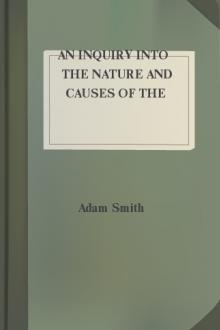The Wealth of Nations by Adam Smith (the best motivational books .TXT) 📕

- Author: Adam Smith
Book online «The Wealth of Nations by Adam Smith (the best motivational books .TXT) 📕». Author Adam Smith
The writing and artwork within are believed to be in the U.S. public domain, and Standard Ebooks releases this ebook edition under the terms in the CC0 1.0 Universal Public Domain Dedication. For full license information, see the Uncopyright at the end of this ebook.
Standard Ebooks is a volunteer-driven project that produces ebook editions of public domain literature using modern typography, technology, and editorial standards, and distributes them free of cost. You can download this and other ebooks carefully produced for true book lovers at standardebooks.org.
Editor’s IntroductionThe first edition of the Wealth of Nations was published on the 9th of March,1 1776, in two volumes quarto, of which the first, containing Books I, II and III, has 510 pages of text, and the second, containing Books IV and V, has 587. The titlepage describes the author as “Adam Smith, LL.D. and F.R.S. Formerly Professor of Moral Philosophy in the University of Glasgow.” There is no preface or index. The whole of the Contents are printed at the beginning of the first volume. The price was £1 16s.2
The second edition appeared early in 1778, priced at £2 2s.,3 but differing little in appearance from its predecessor. Its pages very nearly correspond, and the only very obvious difference is that the Contents are now divided between the two volumes. There are, however, a vast number of small differences between the first and second editions. One of the least of these, the alteration of “late” to “present,”4 draws our attention to the curious fact that writing at some time before the spring of 1776 Adam Smith thought it safe to refer to the American troubles as “the late disturbances.”5 We cannot tell whether he thought the disturbances were actually over, or only that he might safely assume they would be over before the book was published. As “present disturbances” also occurs close to “late disturbances,”6 we may perhaps conjecture that when correcting his proofs in the winter of 1775–6, he had altered his opinion and only allowed “late” to stand by an oversight. A very large proportion of the alterations are merely verbal, and made for the sake of greater elegance or propriety of diction, such as the frequent change from “tear and wear” (which occurs also in Lectures, p. 208) to the more ordinary “wear and tear.” Most of the footnotes appear first in the second edition. A few corrections as to matters of fact are made, such as that in relation to the percentage of the tax on silver in Spanish America (vol. i, pp. 169, 170). Figures are corrected at vol. i, p. 327, and vol. ii, pp. 371, 374. New information is added here and there: an additional way of raising money by fictitious bills is described in the long note at vol. i, p. 294; the details from Sandi as to the introduction of the silk manufacture into Venice are added (vol. i, p. 379); so also are the accounts of the tax on servants in Holland (vol. ii, pp. 341–2), and the mention of an often forgotten but important quality of the land-tax, the possibility of reassessment within the parish (vol. ii, p. 329). There are some interesting alterations in the theory as to the emergence of profit and rent from primitive conditions, though Smith himself would probably be surprised at the importance which some modern inquirers attach to the points in question (vol. i, pp. 49–52). At vol. i, pp. 99, 100, the fallacious argument to prove that high profits raise prices more than high wages is entirely new, though the doctrine itself is asserted in another passage (vol. ii, p. 100). The insertion in the second edition of certain cross-references at vol. i, pp. 195, 311, which do not occur in the first edition, perhaps indicates that the Digressions on the Corn Laws and the Bank of Amsterdam were somewhat late additions to the scheme of the work. Beer is a necessary of life in one place and a luxury in another in the first edition, but is nowhere a necessary in the second (vol. i, p. 430; vol. ii, p. 355). The epigrammatic condemnation of the East India Company at vol. ii, p. 137, appears first in the second edition. At vol. ii, p. 284, we find “Christian” substituted for “Roman Catholic,” and the English puritans, who were “persecuted” in the first edition, are only “restrained” in the second (vol. ii, p. 90)—defections from the ultra-protestant standpoint perhaps due to the posthumous working of the influence of Hume upon his friend.
Between the second edition and the third, published at the end of 1784,7 there are considerable differences. The third edition is in three volumes, octavo, the first running to the end of Book II, chapter ii, and the second from that point to the end of the chapter on Colonies, Book IV, chapter viii. The author by this time had overcome the reluctance he felt in 1778 to have his office in the customs added to his other distinctions8 and consequently appears on the titlepage as “Adam Smith, LL.D. and F.R.S. of London and Edinburgh: one of the commissioners of his Majesty’s Customs in Scotland; and formerly professor of Moral Philosophy in the University of Glasgow.” The imprint is “London: printed for A. Strahan; and T. Cadell, in the Strand.” This edition was sold at one guinea.9 Prefixed to it is the following “Advertisement to the Third Edition”:—
“The first Edition of the following Work was printed in the end of the year 1775, and in the beginning of the year 1776.





Comments (0)